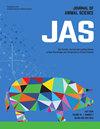2019-2023年绩效指标衡量的奶牛效率:阿拉巴马州肉牛改良协会和阿拉巴马州合作推广系统
IF 2.9
2区 农林科学
Q1 AGRICULTURE, DAIRY & ANIMAL SCIENCE
引用次数: 0
摘要
阿拉巴马州肉牛改良协会(BCIA)商业记录保存计划创建了BCIA性能倡导计划,以鼓励生产者扩大记录保存,以进一步评估整个牛群的性能。犊牛断奶时的体重可作为评价奶牛生产性能和生产效率的指标。从2019年到2023年,10个肉牛养殖场每年收集犊牛断奶时的单头牛体重(n=1430个观察值)。这些操作的平均畜群规模为143头。奶牛年龄分为2 ~ 4岁、5 ~ 8岁和9岁及以上。牛的体重被分为三大类:小(1199磅或以下)、中等(1200至1499磅)和大(1500磅或以上)。每类奶牛的平均体重为小奶牛1117磅(n=396),中等奶牛1336磅(n=859),大奶牛1592磅(n=175)。在各年龄范围和体型类别内,采用奶牛体重与年龄关系、平均产犊间隔、平均小牛调整断奶重和奶牛断奶体重百分比来衡量奶牛生产性能。总体而言,平均奶牛体重为1307磅,平均产犊间隔为377天,平均小牛调整断奶体重为600磅。在不同的年龄类别中,指标略有差异。在奶牛体重类别中,平均产犊间隔随着奶牛体重的增加而增加(从小到大20 d,从中等到大11 d,从小到中等9 d)。无论奶牛年龄如何,大体重组的平均产犊间隔比整体平均产犊间隔长13 ~ 14天。随着奶牛体重的增加,犊牛平均断奶体重也随奶牛年龄的增加而增加(从小到大50磅,从小到中等32磅,从中等到大18磅)。比较不同奶牛年龄和体重类别的小牛调整断奶体重,发现中等和大类别之间存在适度差异(2至4岁9磅,5至8岁15磅,9岁及以上31磅)。奶牛体重与犊牛调整断奶体重的相关性较低(r2=0.0853)。随着奶牛日龄和体重的增加,断奶牛体重百分比逐渐降低(2 ~ 4岁分别为53%、46%、38%;5 ~ 8岁51%、46%、39%;9岁及以上52%,45%,40%分别为小,中,大体重类别)。综上所述,收集犊牛断奶时的体重并测量其对生产性能的影响可以提高生产者对畜群指标、遗传和管理实践的认识,从而努力提高奶牛的生产效率。本文章由计算机程序翻译,如有差异,请以英文原文为准。
63 Cow Efficiency Measured by Performance Metrics 2019-2023: The Alabama Beef Cattle Improvement Association and the Alabama Cooperative Extension System
The Alabama Beef Cattle Improvement Association (BCIA) Commercial Record Keeping Program created the BCIA Performance Advocate Program to encourage producers to expand record keeping for further evaluation of whole herd performance. Collection of cow weight at calf weaning can be used as a metric to evaluate cow performance and efficiency. From 2019 to 2023, ten beef cattle operations collected individual cow weight at calf weaning (n=1430 observations) annually. The average herd size for these operations was 143 head. Cow age was classified as 2 to 4 years old, 5 to 8 years old and 9 years and older. Cow weight was classified into three categories as small (1199 lb or less), moderate (1200 to 1499 lb) or large (1500 lb or greater). Average cow weight per category was small 1117 lb (n=396), moderate 1336 lb (n=859) and large 1592 lb (n=175). Within each age range and size category, cow performance was measured by cow body weight and age relationship, average calving interval, average calf adjusted weaning weight and percentage cow body weight weaned. Overall, average cow weight was 1307 lb, with a 377-day average calving interval and 600 lb average calf adjusted weaning weight. Across age categories, slight differences were shown in metrics. Across cow body weight categories, average calving interval increased as cow body weight increased (20 days from small to large, 11 days moderate to large, 9 days small to moderate). Regardless of cow age, the large weight category maintained average calving intervals 13 to 14 days longer than the overall average. As cow body weight increased, average calf adjusted weaning weight also increased (50 lb from small to large, 32 lb small to moderate, 18 lb moderate to large) regardless of cow age. Comparing calf adjusted weaning weights across cow age and cow body weight categories, modest differences between the moderate and large categories were found (2 to 4 years 9 lb, 5 to 8 years 15 lb, 9 years and older 31 lb). The relationship between cow body weight and calf adjusted weaning weight was low (r2=0.0853). As cow age and weight increases, percentage of cow body weight weaned decreases (2 to 4 years 53%, 46%, 38%; 5 to 8 years 51%, 46%, 39%; 9 years and older 52%, 45%, 40% for small, moderate and large weight categories respectfully). In summary, collecting cow body weight at calf weaning and measuring its impact on performance enhances producer awareness of herd metrics, genetic and management practices to strive to improve cow efficiency.
求助全文
通过发布文献求助,成功后即可免费获取论文全文。
去求助
来源期刊

Journal of animal science
农林科学-奶制品与动物科学
CiteScore
4.80
自引率
12.10%
发文量
1589
审稿时长
3 months
期刊介绍:
The Journal of Animal Science (JAS) is the premier journal for animal science and serves as the leading source of new knowledge and perspective in this area. JAS publishes more than 500 fully reviewed research articles, invited reviews, technical notes, and letters to the editor each year.
Articles published in JAS encompass a broad range of research topics in animal production and fundamental aspects of genetics, nutrition, physiology, and preparation and utilization of animal products. Articles typically report research with beef cattle, companion animals, goats, horses, pigs, and sheep; however, studies involving other farm animals, aquatic and wildlife species, and laboratory animal species that address fundamental questions related to livestock and companion animal biology will be considered for publication.
 求助内容:
求助内容: 应助结果提醒方式:
应助结果提醒方式:


